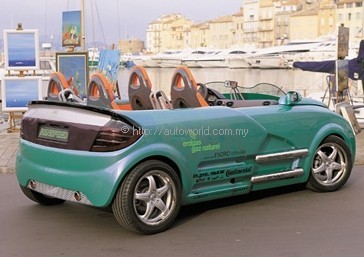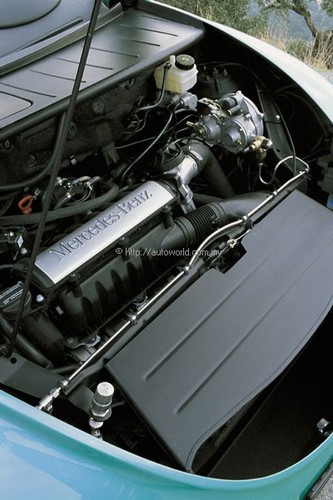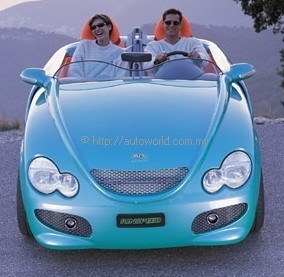Rinspeed’s Variable-Length Presto Roadster
Rinspeed Design of Switzerland celebrates its 25th anniversary this year and on this special occasion, it has built a unique prototype which will be unveiled at the 2002 Geneva Auto Salon next month.
AUTOWORLD.COM.MY managed to get early details of this special car, the Presto, which can transform itself in a few seconds from an under-3-metre long 2-seater roadster into a 3.7-metre long 4-seater with plenty of room for the rear passengers. The additional space can also be used as a pick-up bed for cargo when the rear-seat backrests are folded down.
This almost magical transformation is made possible by a centrally-located electric motor, which stretches the car with the help of two mechanical screw-and-nut gears by exactly 746 mm to its full extended length of 3.74 metres. The longitudinal members run on low-friction precision rollers and disappear like a drawer in the rear of the floorpan.
Despite its variable length, the engineers succeeded in designing the adjustable floorpan with the torsional rigidity necessary for a roadster. To ensure absolute operational safety, the extension mechanism also features self-locking safety latches.
A 4-cylinder, 1.7-litre common-rail turbodiesel engine in dual-fuel configuration, based on a Mercedes-Benz engine, provides future-oriented and highly environment-friendly propulsion. The engine runs on a mixture of natural gas and diesel fuel at a 40:60 ratio. Natural gas is a very clean-burning fuel, which consists almost entirely of methane with sulphur content almost nil. However, since a diesel engine has no spark plug to act as an ignition source, operation on natural gas alone is technically impossible.
The operating principle of the dual-fuel engine is simple. Firstly, natural gas is injected into the intake air of the engine. As in a conventional engine, the diesel fuel is injected into the combustion chamber where it ignites a mixture of natural gas and air, rather than just plain air.
To configure the turbocharged in-line engine for dual-fuel operation, a number of modifications are required, including installation of a tank for the natural gas and a gas-injection system. At the heart of the modifications is a reprogrammed engine management system. Should the system malfunction, it reverts to the standard diesel-mapped ignition, thus offering the same level of reliability as a production car.
This technology has enormous potential for reducing exhaust emissions and fuel consumption. Emissions of nitrous oxides and carbon dioxide can be lowered by as much as 10% compared to the already extraordinary low level of the production engine. Particulate matter emissions can be lowered by up to 40%. With emissions this low, the dual-fuel engine easily meets all existing and currently planned emission limits. Fuel consumption can be improved by up to 10% compared to a production engine.
The dual-fuel engine is compelling proof that environmental protection and driving fun can go hand-in-hand. The 4-valve-per-cylinder engine develops maximum power output of 88 kW/120 bhp at 4200 rpm, and produces maximum torque of 224 Nm at just 1600 rpm. With the light bodywork, brisk performance is assured: This 865-kg ‘quick-change artist’ is claimed to be able to accelerate from 0 to 100 km/h in approximately 10.5 seconds and reach a top speed of approximately 180 km/h. Put wings on it and it may even fly!
It would be hard not to be moved by the ‘smiling face’ of the Presto which is universally appealing. The contoured drooping bonnet sports a mouth-shaped front grille with upturned corners… a way of signalling “Hi! I am in a good mood!” The body of the Presto itself tapers off into a front spoiler; a bumper in the traditional sense of the term is non-existent. Incidentally, the headlights of the Presto come from the Mercedes C-Class sports coupe.
In its role as a quick, highly maneuverable speedster around the city, the Presto appears stocky yet sporty, thanks to extremely short front and rear overhangs. With a wheelbase of 1750 mm and an overall length of 2.99 metres (a Kancil has a wheelbase of 2280 mm and a length of 3.34 metres), it can fit even in the smallest parking spaces.
As a four-seater with a wheelbase of 2496 mm, the roadster appears much sleeker, seemingly poised to strike. The Remus side pipes are more than just a sporty styling element. They also allowed the engineers to avoid a variable and complicated exhaust routing. During the transformation process, the body glides past the side pipes with no interference. Since the Presto does not have any doors, the upper side pipes are designed to swing out and make entering and exiting the vehicle easier for the little ones.
The entire body of the Presto consists of Pre-Preg-Composite, a modern plastic material rarely used in vehicle design for cost reasons. It offers extraordinary stability at comparatively low weight.
The creators of the Presto came up with a very special solution for the vehicle rear and front: instead of conventional light signals ,the Presto informs other drivers in writing about the intent of its driver with innovative LED lighting technology. During braking, STOP appears on the brake lights, and during turns, TURN appears on the appropriate signal. With lights turned on, the taillights proclaim the car’s name to those who follow. A colour camera integrated into the taillights reveals any potential obstacles to the driver in the rearview mirror.
The Presto shows its noble heritage in the interior, too. The dashboard comes from the A-Class and the seats are from the smart car. The fiery-orange interior is as versatile as the body, able to turn into a spacious pick-up or 4-seater roadster at the push of a button. The rear-seat passengers can enjoy more legroom than in an A-Class with long wheelbase. In addition, the rear seats can be folded down individually and make almost any interior configuration possible.
Exclusive reflective upholstery materials create an eye-catching yet comfortable atmosphere. Entertainment in hi-fi quality is provided by a Sony stereo system whose sound is transmitted via wireless headphones. Many clever styling elements for the interior as well as the exterior are also incorporated. A Meta-Sat anti-theft system gives thieves no chance: with GSM and satellite wireless communications, the Presto can be traced, located and immobilized by remote control.
The Presto rolls on one-piece Antera wheels (7.5×17 in front, 8.5×17 in the rear) with the front axle individually suspended on custom-developed Eibach springs. In the rear, a semi-independent suspension also uses custom Eibach springs. To complement the low-emission nature of the Presto, Rinspeed’s designers chose SportContact 2 tyres by Continental (205/50 front and 235/45 rear), which underscore their fuel-saving bionic design with green tyre treads.
Rinspeed’s 46-year old CEO, Frank M. Rinderknecht, used highly advanced technology and a Swiss-based network of automotive and natural-gas specialists for his project. Although there is no automobile production in Switzerland to speak of, there is a very active automotive supply industry there. Many highly innovative prototypes have been developed and manufactured in Switzerland. The competent team translated initial sketches into a fully functional prototype in just four months.


























